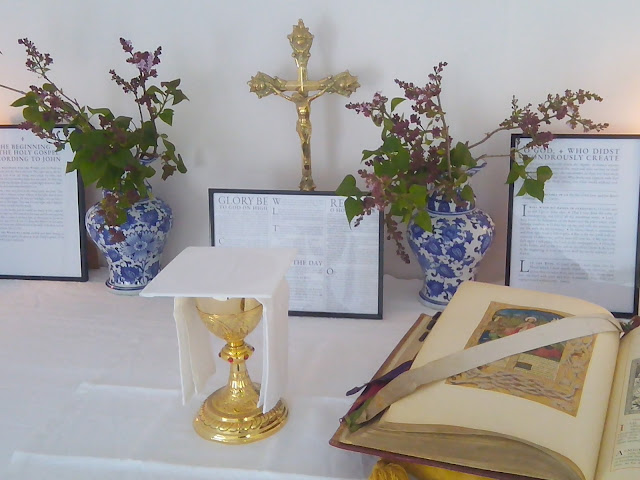St Stephen Harding, depicted in 1125, in the Commentary of St Jerome on Jeremiah now in Dijon library, Bibl Dijon ms 130 fol 104
Stephen Harding (c.1060-1134) was an oblate of the Benedictine Sherborne Abbey in Dorset who left the monastic life and went on a pilgrimage to Rome. On the way back, he passed, like so many mediaeval Englishmen, through Burgundy, where he joined the community of monks at Molesme. Already known for their striving for a more literal observance of the Rule, Stephen was one of the group of monks who then left Molesme to start up the new community at Cîteaux, under Alberic as abbot. Stephen became prior and then abbot in succession to Alberic, and was referred to in the Exordium magnum Cisterciense (of 1190-1210) as having been the "dux et signifer" of the whole Cistercian movement. St Stephen wrote two of the key early Cistercian documents, the Exordium Parvum, detailing the history of the first beginnings of the order, and the Carta Caritatis, the administrative rule or constitution of the order, the earliest extant copy of which, according to Archdale King's Cîteaux and her Elder Daughters, dates from 1194. The extreme simplicity insisted on by St Stephen - silver but not gold chalices; vestments not to be made of silk and of one colour only; iron candlesticks; wooden crosses only - has been called "extreme Puritanism" by Archdale King. (Needless to say, it was so extreme that it didn't last, and by the 15th century, Cistercian abbots wore full pontificalia and their churches differed little from those elsewhere.)
By the time of his death, 75 abbeys had been founded, and he was buried in the cloisters at Cîteaux with his predecessor St Alberic. At the Revolution, in 1791, the bodies were taken to Dijon and hidden, and have not been found again.
Pages from the Bible of St Stephen Harding (Old Testament), now in the municipal library at Dijon. The manuscript contains the sentence Anno Mo centesimo nono ab incarnatione Domini liber iste finem sumpsit scribendi, gubernante Stephano, IIo abbate, cenobium Cisterciense, meaning that it was undertaken under the supervision of Stephen Harding himself.
The beginning of the Acts of the Apostles
From the description of the manuscript on the Dijon municipal library's website: "Retenons l’enluminure au début de l’évangile de saint Luc (fol. 68), initiale P : un jeune homme, possiblement Théophile,
l’ami de Luc, est debout à gauche, appuyé sur le haut de la hampe ; dans la boucle, Luc, nimbé, ses pieds nus écrasant
un dragon, écrit, plume et grattoir en mains, sa copie sur un pupitre posé sur les bras mobiles de son siège : c’est la plus
ancienne représentation d’un tel fauteuil, décrit par l’Anglais Alexandre Neckam dans son De nominibus utensilium (c. 1180)
et familier en Angleterre… d’où Etienne Harding était originaire, nous retrouvons la trace anglaise."
"Le premier style de Cîteaux, dit encore naturaliste ou anglais
(toujours du fait de la présence et de la direction d’Etienne Harding)
est caractérisé par le mouvement et la vitalité des représentations :
majestueux rinceaux de feuillage enserrent personnages et animaux,
vrais ou imaginaires. La violence des guerriers est cependant démentie
par la fragilité de leur rempart longiligne ; de même, l’aspect terrifiant
des dragons est atténué par la délicatesse des couleurs dont ils se
parent et l’absence de lignes brisées : les monstres tout en courbes
et en arrondis suggèrent davantage les insinuations diaboliques que
des créatures cauchemardesques. Un processus, initié dans les ateliers
carolingiens, est repris à l’envi, celui de la lettre «synthétique», dessinée
par la posture des éléments. L’environnement familier, la forêt, le travail
manuel, la palette réduite des couleurs, traduisent les choix cisterciens
exprimés par le moine-peintre, peut-être Etienne Harding lui-même."
Pleade 4.0 — Manuscrits de Cîteaux (FR212316101_citeaux) (bm-dijon.fr)
The 1930s statue of St Stephen Harding at Cîteaux
His feast day is kept on 26th January

.png)




.png)
